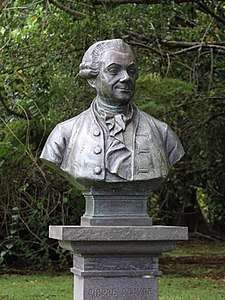Pierre Poivre
Pierre Poivre (23 August 1719 – 6 January 1786) was an 18th-century horticulturist and botanist. He was born in Lyon, France.


He was a missionary to East Asia, intendant of French colonial islands in the Indian Ocean, and wearer of the cordon of St. Michel.[1]
Career
In his early 20s Poivre was a missionary in Far Eastern locations that included Cochinchina, Guangzhou, and Portuguese Macau. In 1745 as a member of the French East India Company, while on a journey to the East Indies, he was struck by a cannonball on the wrist while being engaged in a naval battle with the British. The injury required the amputation of part of his right arm.
- Botanical garden
In the 1760s, Poivre became administrator intendant of Isle de France (in present-day Mauritius) and Ile Bourbon (in present-day Réunion) in the West Indian Ocean. On northern Isle de France—Mauritius, he is renowned for the establishment of a new botanical garden, the present day Sir Seewoosagur Ramgoolam Botanical Garden (Botanical Garden of Pamplemousses), with specimens of trees, shrubs and plants imported from tropical habitats worldwide. He was succeeded as its director by botanist Jean-Nicolas Céré. Today on northern Mauritius, the SSR Botanical Garden−Botanical Garden of Pamplemousses still flourishes, and is now a 25 hectares (62 acres) garden containing tropical plants and trees from other islands in the Indian Ocean, Africa, Asia, the Americas, and Oceania.
- Spice trade
Poivre is also remembered for introducing spice plants to Mauritius and Reunion, such as clove and nutmeg, commodities which at the time were controlled by the Dutch, who had a virtual monopoly on them in the Dutch East Indies. In order to obtain the spices, Poivre arranged clandestine smuggling forays to obtain plants and seeds from the Dutch Spice Islands in 1769–1770.[2] Poivre was also responsible for introducing spice plants to the Seychelles.
Publications
- Voyages of a Philosopher − Voyages d'un philosophe ou observations sur les moeurs et les arts des peuples de l'Afrique, de l'Asie et de l'Amérique — Fortuné-Barthélemy de Félice, 1769.[3] The book was read with interest by Thomas Jefferson, his description of mountain rice cultivated in Vietnam caught Jefferson's attention.[4]
- Tableau historique de l'Inde, contenant un abrégé de la mithologie et des mœurs indiennes — Aux dépens de la Société typographique, 1771.[5]
Taxonomy
Family
Pierre Poivre married Françoise Robin (1749 - 1841) on 5 September 1766 in Pommiers, Rhône. They had three children:
- Marie Poivre (1768 - 1787)
- Françoise Julienne Ile-de-France Poivre (1770 - 1845), married Jean-Xavier Bureau de Pusy (1750 - 1806)
- Sarah Poivre (1773 - 1814)

He was an uncle to the renowned French naturalist Pierre Sonnerat (1748-1814).
- Honors
The Poivre Islands coral atoll is named in his honor. They are located in the Amirante Islands group of coral islands and atolls that belong to the Outer Islands of the Seychelles.
Pierre's surname means pepper (Poivre;![]()

References
- Lewis A. Maverick (June 1941). "Pierre Poivre: Eighteenth Century Explorer of Southeast Asia". The Pacific Historical Review. 10 (2): 165–177. JSTOR 3633634.
- Charles Corn (1998). The Scents of Eden: A Narrative of the Spice Trade. Kodansha America. p. 223. ISBN 1-56836-202-1.
"Provost set out in May 1769 for the Spice Islands ... Poivre had been a tireless collector of intelligence on the islands, and his sources informed him of the discovery of a small, uninhabited island northwest of Ternate called Miao, where spices grew in abundance and the Dutch were not especially vigilant as to its security."
- Books.google.com: Voyages of a Philosopher− by Pierre Poivre, 1769.
- Monticello.org: Thomas Jefferson Encyclopedia − "Rice"
"Jefferson now turned his attention from the commercial success of his southern countrymen to their health. In the summer of 1787 he began to wonder whether the culture of dry rice might "enable us to get rid of those ponds of stagnant water so fatal to human health and life." He had been reading the Voyages d'un Philosophe by Pierre Poivre, a man who had traveled the Far East as a missionary — first for the Catholic faith and then for French colonial agriculture. During an adventurous life, in which he was captured three times by the British, Poivre introduced the nutmeg, clove, and other Asian plants to the colonies of Isle de France and Ile Bourbon. To break the Dutch monopoly of the spice trade, he too resorted to smuggling, and even to night raids. But it was Poivre's description of the mountain rice of Vietnam, a country ruled by philosopher-princes, that particularly caught Jefferson's attention."
- Books.google.com: Tableau historique de l'Inde, contenant un abrégé de la mithologie et des mœurs indiennes − Pierre Poivre, 1771.
- IPNI. Poivre.
- S. Hassall; P.J.Hassall (1988). "Exploration, Discovery and Settlement". Seychelles. Places and People of the World. Chelsea House. p. 26. ISBN 0-7910-0104-0.
- Guy Lionnet (1972). "Geography, Geology and Government". The Seychelles. The Islands Series. Stackpole Books (U.S.) / David & Charles (UK). p. 28. ISBN 0-8117-1514-0.
External links

- Travelmauritius.info: Photos of the Sir Seewoosagur Ramgoolam Botanical Garden—Botanical Garden of Pamplemousses
- Gaiadiscovery.com: "Mauritius Heritage in Pamplemousses Gardens"
| Wikimedia Commons has media related to Pierre Poivre. |